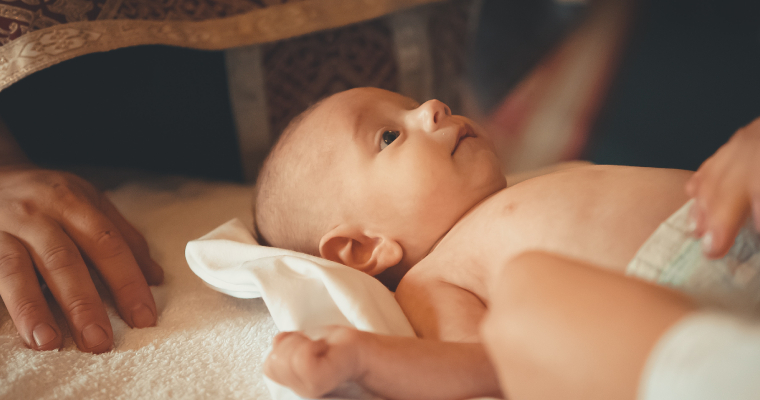Baby Born with Teeth
- Baby Born with Teeth
-
- UPDATED JULY 14, 2022

by Tasha Mayberry
430 shares
Teething is one of the major milestones in a baby’s development, which happens usually around 4 to 7 months of their age. In most babies, the first set of teeth that come out would normally be the bottom front ones, which are called the central incisors. However, some babies are born with one or more teeth, which are referred to as natal teeth. This is a rare occurrence, and it is natural for any parent to be taken aback or shocked to see their baby born with teeth.

Natal Teeth
Known to occur in 1 in 3000 births, natal teeth are teeth that a baby has when he/she is born, but these teeth may have a weak root and are not fully developed. People often get confused between natal and neonatal teeth, thinking both are the same, but they are different. As mentioned, natal teeth are present right from a baby’s birth, whereas neonatal teeth tend to erupt within a month after birth.
Even in babies with natal teeth, the first growth tends to be on the bottom front gums, and they often grow in pairs as well. While you may spot natal teeth on the top front gums too, this occurrence is comparatively less, and the growth of other teeth, such as molars, are rather uncommon. Though natal teeth look like regular baby teeth, they are, however, smaller and a bit yellowish in color. They also tend to be wiggly due to their weak roots.
Causes of Natal Teeth
Though there is no one cause or reason for babies to be born with natal teeth, there are certain factors that can contribute to the same. One of the prominent factors is their genetic blueprint/ hereditary reasons. For instance, if you or your partner were early teethers or late teethers, there is every possibility that your little one will carry the same genetic characteristic. Also, a study has revealed that 15% of babies born with natal teeth had their siblings, parents, or other relatives encounter the same occurrence.
On the other hand, babies being born with teeth can also be due to certain underlying medical conditions, such as:
- Sotos syndrome – a genetic disorder characterized by excessive growth both before and after birth.
- Ellis-van Crevald syndrome – a rare genetic disorder characterized by additional toes/fingers, short limb dwarfism, etc.
- Hallermann-Streiff syndrome – a congenital disorder that affects dental development, growth, and more.
- Pierre Robin syndrome/sequence – a condition where the lower jaw will be smaller than normal, the tongue falls back in the throat, and causes difficulty in breathing.

Possible Complications of Natal Teeth
While natal teeth in infants are rare, if it does occur, some of the possible complications are:
- Since natal teeth can be discomforting and painful for babies while suckling, many infants may find it difficult to breastfeed and therefore refuse to nurse.
- Natal teeth usually have weak roots, which means they are likely to be loose and can break free any time. This causes a choking hazard to infants, as there is a possibility of them accidentally inhaling the tooth into their airway and lungs.
- It can also cause injury to the baby’s tongue and to mom’s nipple while breastfeeding.
- As natal teeth constantly rub against the underside of the infant’s tongue, it can cause a form of tongue ulcer, called Riga-Fede disease (RFD), which can be painful and prevent the baby from breastfeeding.
Natal Teeth Diagnosis
Natal teeth can be diagnosed by your baby’s dentist or doctor by conducting a physical examination, followed by an X-ray, which will deliver a clear picture of the teeth’s structure, root strength, etc.
Treatment for Natal Teeth
In most cases, your child’s dentist or doctor may declare that there is no need for a treatment plan for the natal teeth. However, if the X-ray shows that the teeth are loose because of the underdeveloped or weak root, the dentist or doctor might choose to remove the teeth to reduce the risk of your baby inhaling them into their airways.

When to Seek Medical Help
Natal teeth are just like normal baby teeth, just that they erupt very early. As long as your baby’s natal teeth don’t make it difficult for your little one to breastfeed or cause any other issues, like tongue ulceration, breathing difficulty, etc., you don’t necessarily have to worry about them, and they will eventually fall out just like any other teeth, at the appropriate age.
However, if the natal teeth in your baby turn out to be causing a lot of disruptions in his/her health and regular routines, like nursing, you might want to consult with your child’s dentist or health care provider to come up with the right solution. As discussed before, if the teeth seem to be loose, they might have to be removed; and, if they seem to cause Riga-Fede disease, the dentist may suggest smoothing the rough edges of the teeth to protect your baby’s tongue, thereby preventing the ulcer.

Babies being born with teeth, though rare, is a possible occurrence and there is nothing much for the parents to worry about. If the presence of the teeth does not seem to pose any risk to the little one, you can care for them just like you would their regular teeth, brushing them twice a day, making regular visits to the dentist, etc.